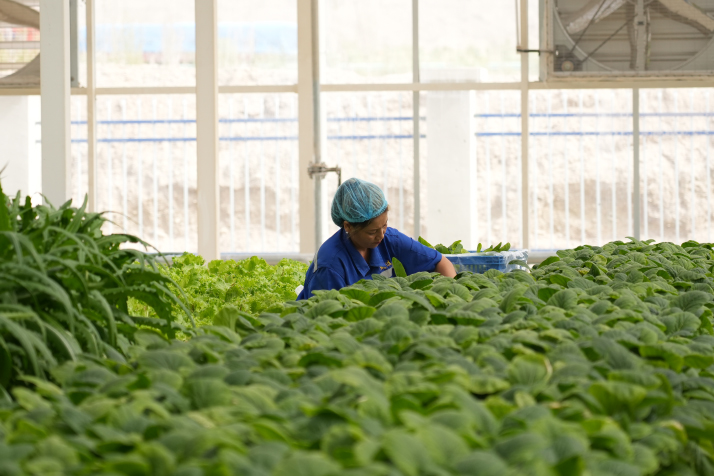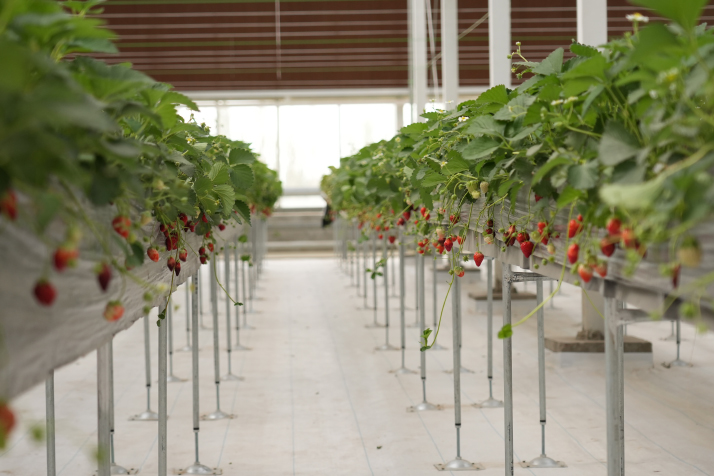| Xinjiang Today |
| Green prosperity | |
|
|
 A worker harvests vegetables in a smart plant factory in Kuche City, Aksu Prefecture, on May 19 (LI FANGFANG)
Inside a smart greenhouse in the south of Xinjiang, vertical cultivation racks brim with ruby-red strawberries and thriving leafy greens. This facility is one of many now dubbed plant factories, making use of new smart technologies to enable year-round production. The Yongkutongxin Village Smart Plant Factory, located in Kuche (Kuqa) City, Aksu Prefecture, is the first smart agriculture facility in south Xinjiang to be established under a program for shared prosperity. Built as part of a cooperation initiative between Xinjiang and Ningbo City in Zhejiang Province, it generates around 600,000 yuan ($83,429) in annual collective income for the village. Ningbo's cooperation with Xinjiang is part of the latest round of pairing-up assistance in the autonomous region, which started in 2010. The pairing-up assistance program was first introduced by the Central Government in 1997, with the current round pairing well-developed provinces and cities in east China with less developed cities and prefectures in Xinjiang to boost growth in the recipient locations. With the support of Ningbo, Kuche has focused on investment attraction to develop its agricultural industry. "Through exchanges between the two regions, Kuche has adopted effective practices from rural revitalization models used in Zhejiang," Li Qiaoqiao, a member of a team of Ningbo officials stationed in Xinjiang for assistance initiatives, told Xinjiang Today. China's rural revitalization, a strategy introduced in 2017, aims to promote the economic prosperity and overall development of rural areas.  Strawberries grown in a smart plant factory in Kuche on May 19 (LI FANGFANG)
Smart operation With a total investment of 20 million yuan ($2.8 million), the plant factory uses hydroponics and automated climate control to grow vegetables, fruit and medicinal herbs unaffected by the dry, dusty surroundings of the Taklimakan Desert, China's largest desert and the world's second largest shifting sand desert. Covering 6,912 square meters, the glass greenhouse combines artificial and natural light with smart systems that control light intensity, temperature, humidity and carbon dioxide levels. It has leveraged the local natural advantage of abundant sunlight to enable year-round production. The project was initiated in 2023 to ensure fresh vegetable supply during winters in Xinjiang and became fully operational in October 2024. Li Songsong, technical director at Kuche Zhenxuan Supply Chain Co., which runs the factory, told Xinjiang Today that the company focuses on developing branded, market-ready products and helps farmers improve yields through training. To meet local demand, the facility cultivates 10 types of hydroponic vegetables, including spinach, lettuce and cilantro, on customized soilless planting beds. Nutrient-rich water flows through each bed, providing oxygen and essential elements and minerals to the roots of each plant. Factory staff undergo disinfection before entering the operation zone to protect the plants from pests and diseases. "Our vegetables are completely free of pesticides, heavy metals and chemical residues. Consumers can eat them straight from the field. The vegetables have three times more vitamin C than conventional ones," Li Songsong said. Thanks to the optimized growing environment, crop cycles from seeding to transplanting are half as long. In May, it takes only 11 days for spinach to be ready to transplant, whereas with traditional growing approaches, it takes about 32 days. The plant factory is projected to produce over 500 tons of vegetables and fruit annually, providing supplies for high-end supermarkets in Xinjiang, Li Songsong said. Green fortune Backed by funding and technical support from Ningbo, the agricultural project has boosted development in Kuche by providing jobs and technical training to the villagers. Ali Keram, a former ranch worker from Kuche, started working at the factory last September. "Our farming used to rely on nature—now it runs on innovation," he told Xinjiang Today. In the plant factory, smart irrigation systems automatically monitor water use, leaf residue and irrigation timing, greatly saving human labor. Ali works there with another 25 fellow villagers for around eight hours a day. Ali said he has learned the innovative method of growing high-quality leafy vegetables using nutrient solutions and water, a technique that was unfamiliar to him before. He and his colleagues' tasks now include monitoring the plant factory's lighting conditions, temperature, humidity, carbon dioxide levels and the pH of the nutrient solution. By scanning a QR code, they can view growth data for the crops in their care. The new job has also improved his life. "The factory is pretty close to my home, so I can go back for a rest during the midday break every day. And I have more time to take care of my child," he said. He now earns a monthly salary of 4,000 yuan ($556), which is higher than his previous earnings from part-time jobs. According to Li Qiaoqiao, the plant factory is expanding into areas including fresh juice production, leisure tourism, e-commerce and vocational training. Through the factory, Kuche is developing a farm-to-table supply chain to become an agricultural hub. The second phase of the factory, currently under planning, will enter the flower cultivation and educational tourism sectors, he said, adding that in addition to agriculture, Kuche has also been developing eco-tourism and homestays to create local jobs in recent years. Similar plant factories have been built in many regions across Xinjiang. At an agricultural demonstration zone in Changji Hui Autonomous Prefecture in north Xinjiang, a plant factory is dedicated to growing vining plants such as tomatoes in a glasshouse, maximizing their exposure to sunlight and fertilizer. The isolated environment has helped reduce the impacts of diseases and pests. With exceptional quality, Xinjiang tomatoes are highly sought after in international markets. Tomato paste is among the region's top exports. Hydroponic tomatoes have a longer growth cycle than traditionally grown ones—taking about two months from planting to harvest. This extended period allows the tomatoes to fully develop their natural flavor. Thanks to year-round production in the plant factory, its tomato yields are much higher than traditional field production. The harvest season lasts from October to July the next year, with an average daily output exceeding 300 kg. Tomatoes grown there are typically sold at three to four times the price of traditionally cultivated ones, both domestically and to other countries. In recent years, Xinjiang has attached great importance to the development of greenhouse agriculture and smart farming. As of 2023, the region had more than 1.2 million green farming setups, involving a growing area exceeding 44,600 hectares in total, according to the local department of agriculture and rural affairs. Yu Jingquan, a member of the Chinese Academy of Engineering, told Xinhua News Agency that northwest China is suitable for the development of greenhouse agriculture as the region has abundant uncultivated land that can be utilized to increase the scale of farming and reduce costs. Natural conditions such as abundant light and heat also ensure the quality of plants grown in the region. Greenhouse agriculture gives a strong boost to farmers' incomes, Yu said. Comments to lixiaoyang@cicgamericas.com |
|
||||||||||||||||||||||||||||
|